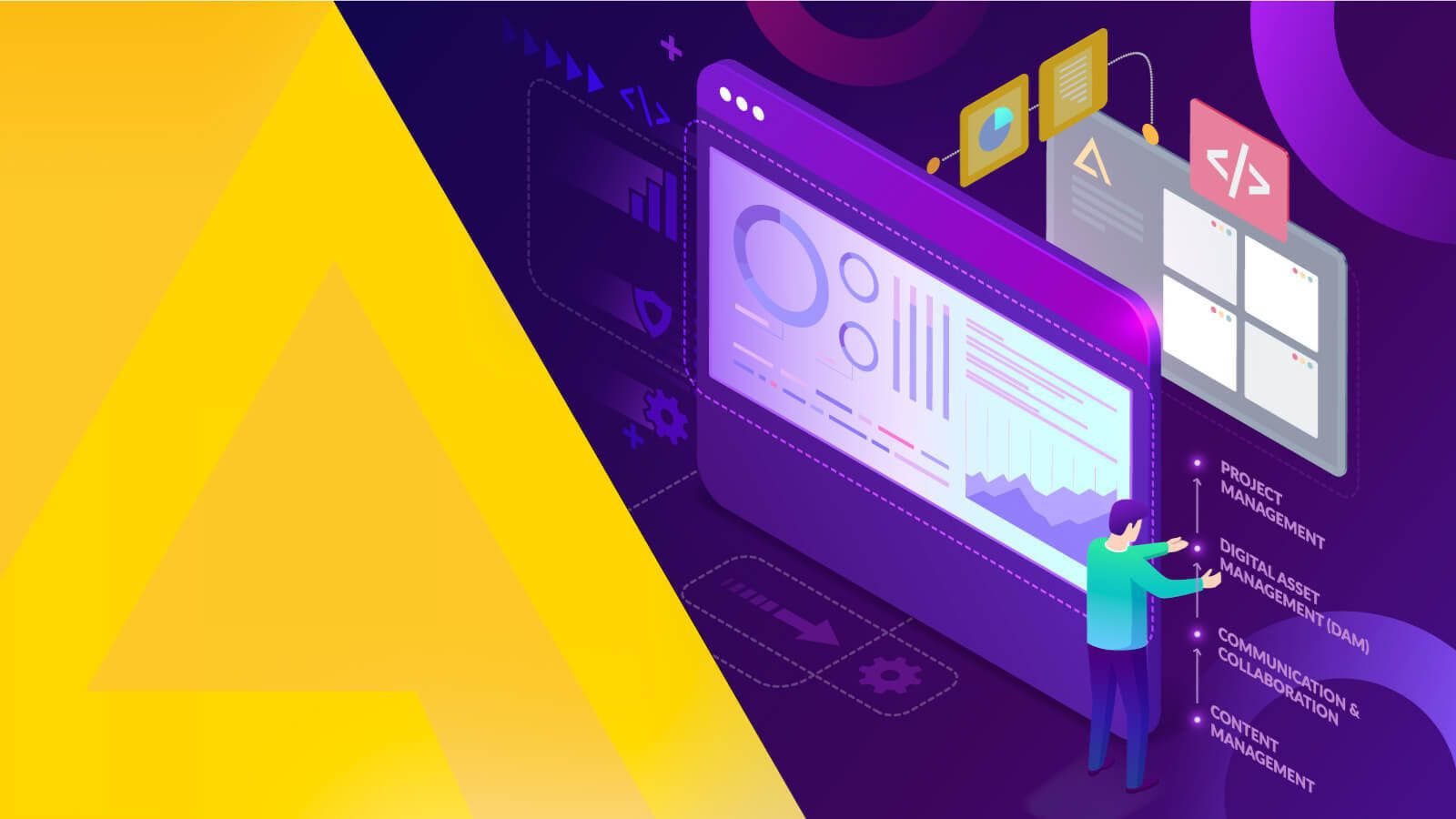Modern enterprises turn to business management software to help them improve and automate their business processes. As companies undergo digital transformation, remote work continues to expand, and new technologies are unveiled yearly, choosing the right business management software is crucial.
From project management and collaboration tools to knowledge management and business intelligence software, organizing all these tools and getting the most out of them is a significant challenge. Yet as the number of business management software solutions continues to grow, businesses need to find a way to create the best experience for their employees without them getting overwhelmed.
A headless CMS can help connect multiple tools while optimizing the digital experience. In this post, we’ll explain what businesses need to consider and highlight how a headless CMS can answer all of their problems.
Business Management Software: All-in-one vs. Build It Yourself
With the number of business management software tools the average enterprise company needs, there is usually one major question they typically need to answer. Go for an all-in-one suite or choose to build one yourself?
The Drawbacks of All-in-one Solutions
Many companies still opt for an all-in-one solution because it can give them everything they need in one system. There are some benefits to this best-of-suite approach, such as learning how to use one vendor interface, and implementation times can be faster. You only need to worry about one system.
Businesses often have to work with the suite provided to them by the vendor, and certain integrations might not always function as well since they come from a third party. Additionally, these suite systems don’t necessarily provide the best tools on the market. On the one hand, it might provide an excellent project management tool, but the collaboration features, business intelligence, and analytics tools might not be up to scratch.
Building It Yourself With Best-of-Breed
Rather than choose an all-in-one suite that doesn’t necessarily contain the best tool for every required function, companies can opt for a best-of-breed approach. With this option, it’s possible to select the best tool for every specific function and integrate them into one complete system.
On the surface, having to work with multiple vendors and various software tools might seem like an unnecessary burden for a company to undertake. However, given the multilayered needs of companies today, not taking a best-of-breed approach could see enterprises scrambling to integrate additional tools into their all-in-one suite anyway.
Building an enterprise business management software stack using best-of-breed tools makes it possible to take advantage of a few benefits. The build-it-yourself approach future-proofs the business against the need for ongoing change. It also enables greater flexibility and adaptability in changing market conditions and allows businesses to select the best tools on the market for their specific needs.
The Changing Business Management Landscape
Business management software solutions continuously evolve as remote work advances, and companies embrace concepts like cloud computing and infrastructure. The build-it-yourself approach offers organizations the flexibility needed to stay on top as the business management landscape changes.
A Huge Collection of Tools
One of the most significant challenges modern enterprises face is the sheer number of software applications they need to account for. According to Statista, companies worldwide used 110 different SaaS applications on average in 2021. That’s a huge amount of tools to account for.
Businesses must also ensure that they have complete visibility of these applications. Otherwise, they risk not utilizing them correctly, paying for several tools their employees aren’t aware of, or only using them sparingly.
Modern Approaches Desired
Another factor impacting the current business management landscape is that more and more businesses are taking a composable approach to build their technology stacks. As a result, business management tools will also be affected. Modern companies are adopting concepts such as MACH (Microservices, APIs-first, Cloud-native, and Headless) to achieve their desired agility.
By adopting these concepts, enterprises can build a modular architecture that allows them to deploy new features and innovate quickly. Additionally, it enables businesses to create and deliver digital experiences that delight their customers and improve the employee experience.
Tools to Consider For Your Business Management Needs
While the average enterprise might use tens of software tools as part of their tech stack, some core areas should be considered for business management requirements.
- Project Management: Project management tools such as Trello and Asana are standard for any digital business. These tools help companies to organize their tasks, keep track of deadlines and ensure that everything is up to date.
- Digital Asset Management (DAM): Digital asset management tools are essential for digitizing your business and keeping everything in one place. DAMs can act as a central hub where your content and digital assets are stored, making it easy to find when it comes.
- Communication & Collaboration: Communications tools provide the asynchronous messaging that organizations expect today. Instant messaging rather than emailing to schedule tasks using collaboration tools like Slack, Confluence, and Zoom can streamline communication and ensure that nothing falls through the cracks. These tools have often replaced traditional intranets and can be used alongside modern interpretations of intranets to great effect.
- Content Management: Content management software is necessary to create and manage the text, images, and more that communicate the company message and campaigns to customers.
Building Viable Solutions With a Headless CMS
Organizations that need a way to build their enterprise business management software stack should look no further than a headless CMS. Unlike traditional CMS platforms that are only capable of handling content management for one channel, like a website, a headless CMS can do so much more.
Decoupling the frontend and backend from each other, allowing them to communicate using APIs, opens up a realm of possibilities that legacy CMS architectures can’t provide. Here are some advantages businesses can gain from using a headless CMS for enterprise business management.
Omnichannel Digital Experiences
Digital experiences can be delivered to any channel. This bodes well for customers viewing content on smartphones and tablets. Content can be seamlessly connected across channels.
Composable Solutions
Another advantage of a headless CMS is that it supports composable solutions. Businesses don’t need to choose an expensive all-in-one suite that might offer a decent CMS but is lacking in several other areas. Instead, they can compose their entire tech stack by selecting different best-of-breed tools for each function.
Avoid Lock-In
With a headless CMS, vendor lock-in no longer needs to restrict companies. They have the freedom and flexibility to select tools that work for them without worrying about being locked into a long licensing period.
Flexible Intranets
For the employee experience having an intranet can help to keep communication and information sharing secure. It can also make onboarding, knowledge sharing, and other tasks more manageable. With a headless CMS, businesses can create customized intranets that fit their needs and avoid integrating another third-party tool.
Agility: A Content Platform At the Heart of Your Business Software Stack
As the enterprise business management landscape evolves, brands need access to the right tools to build a custom tech stack, streamline the number of tools they need, and embrace modern approaches.
Agility is a modern platform that can help businesses achieve these requirements. A headless platform that sits at the heart of the business software stack, businesses can leverage Agility to create engaging digital experiences while keeping all their files and content assets organized.
Agility is built on an architecture that allows developers to use the latest web technology and whatever framework they deem fit. However, marketers also gain access to a familiar authoring platform with an intuitive user interface that helps them create experiences that delight customers.
See how Agility can help you by requesting a demo.



